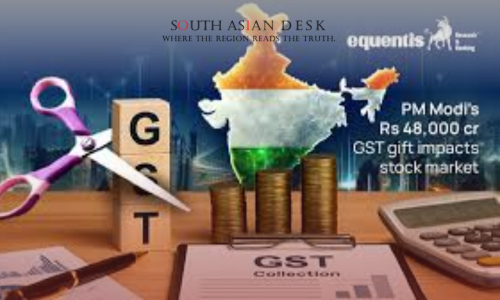New Delhi, September 8, 2025 – Will sweeping GST reforms spark a new market rally, or will global risks temper the gains?
The GST rate cuts Indian stocks 2025 narrative gained momentum after the GST Council, on Wednesday, September 3, 2025, slashed rates to two slabs—5% and 18%—effective Monday, September 22, 2025, in New Delhi, aiming to boost consumption and ease living costs, driving stock market optimism.
The GST rate cuts Indian stocks 2025 are pivotal for South Asia’s largest economy, promising to enhance consumer spending, bolster corporate earnings, and fuel growth in sectors like FMCG, autos, and insurance, potentially reshaping India’s economic trajectory amid global uncertainties.
GST Rate Cuts Indian Stocks 2025: A Transformative Reform
The GST Council, chaired by Finance Minister Nirmala Sitharaman, announced a landmark overhaul of India’s Goods and Services Tax (GST) system during its 56th meeting, reducing the existing four-tier structure (5%, 12%, 18%, 28%) to two primary slabs: 5% and 18%. A 40% rate was introduced for select luxury and “sin” goods like tobacco and high-end cars. According to the Ministry of Finance, these changes, effective from Monday, September 22, 2025, aim to simplify compliance and reduce costs for consumers, with an estimated revenue loss of INR 480 billion (USD 5.5 billion).
The gst reforms impact on stock market was immediate, with the NSE Nifty 50 rising 0.25% to 24,802.6 and the BSE Sensex climbing 0.24% to 80,904.4 on Monday, September 8, 2025, at 9:15 AM IST, buoyed by both GST cuts and expectations of a US Federal Reserve rate cut. All 16 major sectors logged gains, with small- and mid-cap indices up by 0.3% each.
According to Nirmala Sitharaman’s office on X, posted on Tuesday, September 3, 2025, the reforms align with Prime Minister Narendra Modi’s Independence Day pledge for “next-generation GST reforms,” targeting affordability and economic growth. The timing, coinciding with Navratri, positions the cuts as a festive boost for consumers.
GST Reforms Impact on Stock Market: Sectoral Winners
Cross-verification from the Press Information Bureau confirms the reforms focus on relief for the common man and businesses, with exemptions on life and health insurance premiums and reductions on daily essentials like paneer, roti, and dairy products to 0% or 5%.
FMCG and Consumer Durables Surge
The gst reforms impact on stock market is most pronounced in fast-moving consumer goods (FMCG) and consumer durables. Companies like Hindustan Unilever, Nestle, and Godrej Industries are set to benefit from reduced rates on soaps, shampoos, and packaged foods, now taxed at 5% instead of 18%. Consumer electronics such as TVs, air conditioners, and dishwashers, previously at 28%, will now attract 18% GST, boosting firms like LG Electronics and Voltas.
Analysts project a 5-7% stock price rise for FMCG giants like ITC and Dabur, driven by lower prices spurring demand. Union Commerce Minister Piyush Goyal, speaking at the India MedTech Expo 2025 on Thursday, September 4, 2025, urged industries to pass on these savings, stating, “Every consumer stands to benefit,” and described the reforms as “game-changing” for economic growth.
Auto Sector Gains Traction
The gst rate cuts Indian stocks 2025 narrative strongly features the automotive sector. Small cars (petrol <1,200 cc, diesel <1,500 cc, length <4,000 mm) and motorcycles up to 350 cc now face 18% GST, down from 28%, benefiting Maruti Suzuki, Tata Motors, and Hero MotoCorp. Auto components also dropped to 18%, supporting ancillary firms. Electric vehicles remain at 5%, while hydrogen fuel cell vehicles shifted from 12% to 5%.
Market expert Dr. VK Vijayakumar of Geojit Financial Services noted on Thursday, September 4, 2025, that the gst reforms impact on stock market could trigger a “virtuous cycle” of demand, earnings, and investment, potentially pushing India’s GDP growth to 6.5% in FY26.
Insurance and Cement Sectors Rally
The exemption of GST on individual life and health insurance policies, including family floaters and senior citizen plans, has sparked a rally in insurance stocks. Star Health surged over 9% on Thursday, September 4, 2025, with LIC and SBI Life also gaining. Cement stocks like UltraTech and ACC benefit from an 18% GST rate, down from 28%, indirectly aiding real estate.
Challenges and Risks Amid GST Rate Cuts Indian Stocks 2025
Despite the optimism, concerns linger about whether companies will fully pass on savings to consumers. Finance Minister Nirmala Sitharaman, in an India Today TV interview on Friday, September 5, 2025, emphasized that the Central Board of Indirect Taxes and Customs (CBIC) will monitor compliance to ensure benefits reach the “aam aadmi.”
The revenue loss of INR 480 billion raises fiscal deficit concerns, though analysts suggest long-term consumption gains could offset this. Global risks, including potential US tariffs under a Trump administration, may also temper the gst reforms impact on stock market, with traders advised to watch Nifty support at 24,650.
Background
Introduced in 2017, India’s GST unified a fragmented tax system but faced criticism for its complexity. The 2025 reforms, announced by PM Modi on August 15, 2025, aim to streamline slabs and boost consumption ahead of Diwali. Previous GST tweaks in 2024 had limited impact, but the current overhaul targets over 90 stocks across autos, FMCG, and insurance, with a projected: 1-2% GDP growth boost.
What’s Next for GST Rate Cuts Indian Stocks 2025
The CBIC will engage with industries to ensure price reductions by Monday, September 22, 2025, while investors eye Nifty targets of 25,100. The gst rate cuts Indian stocks 2025 could sustain market momentum, but success hinges on consumer pass-through and global economic stability.
Published in SouthAsianDesk, September 8th, 2025
Follow SouthAsianDesk on X, Instagram, and Facebook for insights on business and current affairs from across South Asia.






